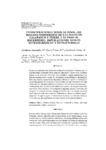Mostrar o rexistro simple do ítem
Consideraciones sobre el final del relleno endorreico de las fosas de Calatayud y Teruel y su paso al exorreísmo. Implicaciones morfoestratigráficas y estructurales
| dc.contributor.author | Gutiérrez Santolalla, F. | |
| dc.contributor.author | Gracia Prieto, F. J. | |
| dc.contributor.author | Gutiérrez Elorza, M. | |
| dc.date.accessioned | 2010-01-22T13:24:26Z | |
| dc.date.available | 2010-01-22T13:24:26Z | |
| dc.date.issued | 1996 | |
| dc.identifier.citation | Cadernos do Laboratorio Xeolóxico de Laxe, 1996, 21: 23-43 ISSN: 0213-4497 | es_ES |
| dc.identifier.issn | 0213-4497 | |
| dc.identifier.uri | http://hdl.handle.net/2183/6227 | |
| dc.description.abstract | [Resumen] Se pone en evidencia como la edad de la Superficie de Erosión Fundamental y el final del relleno endorreico de las fosas de Calatayud y Teruel, en la Cordillera Ibérica, no es un evento isócrono, sino variable en ambas depresiones yen. distintos sectores de una misma. La información geomorfológica y estratigráfica demuestra como la captura de una depresión endorreica y su paso al exorreismo es un proceso gradual en el espacio y en el tiempo, sin que necesariamente esté relacionado con estímulos tectónicos o climáticos. Así un intervalo de tiempo postcaptura puede estar representado en distintos sectores de una fosa por sedimentos endorreicos, hiatos erosivos o de no depósito y depósitos aluviales exorreicos. Por otra parte se cuestiona la cronoestratigrafía tradicional de los mantos aluviales depositados en condiciones exorreicas. Finalmente se esboza la evolución espacio temporal de la captura y paso al exorreismo de las fosas de Calatayud y Teruel y de las semifosas pliocuaternarias del sector central de la Cordillera Ibérica. | |
| dc.description.abstract | [Abstract] It is shown how the age of the "Fundamental Erosión Surface" and the end of the endorheic infill of Calatayud and Teruel grabens, in the Iberian Range, is not isochronous, but variable between both basins and among different sectors of a certain one. Both, geomorphological and stratigraphical evidences demonstrate how the capture of an endorheic basin and its transition to exorheic conditions is a gradual process, which not necessarily has to be related with tectonic or climatic factors. A po~t-capture time span may be represented in different sectors of a graben by endorheic sediments, erosional and nondepositional hiatus and alluvial exorheic deposits. On the other hand, the traditional chronostratigraphy of the alluvial fans deposited under exorheic conditions is argued. Finally, the space and time evolution of the capture and transition to exorheic conditions in Teruel and Calatayud grabens and in the Plioquaternary halfgrabens of the central sector of the Iberian range is outlined. | |
| dc.language.iso | spa | es_ES |
| dc.publisher | Universidade da Coruña | es_ES |
| dc.subject | Cordillera Ibérica | es_ES |
| dc.subject | Fosas de Calatayud y Teruel | es_ES |
| dc.subject | Semifosas pliocuaternarias | es_ES |
| dc.subject | Captura | es_ES |
| dc.subject | Exorreismo | es_ES |
| dc.title | Consideraciones sobre el final del relleno endorreico de las fosas de Calatayud y Teruel y su paso al exorreísmo. Implicaciones morfoestratigráficas y estructurales | es_ES |
| dc.type | info:eu-repo/semantics/article | es_ES |
| dc.rights.access | info:eu-repo/semantics/openAccess |






